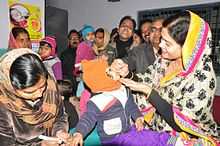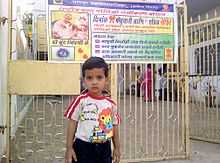Pulse Polio


Pulse Polio is an immunisation campaign established by the government of India in 1995-96 to eradicate poliomyelitis (polio) in India by vaccinating all children under the age of five years against polio virus. This project deals with the ways to fight poliomyelitis through a large scale immunisation programme, co-operating with various international institutions, state governments and Non Governmental Organisations, as part of the Global Polio Eradication Initiative, spearheaded by Rotary International, the World Health Organization, UNICEF, and the U.S. Centers for Disease Control and Prevention.
In India, vaccination against Polio started in 1978 with Expanded Program in Immunisation (EPI). By 1984, it was successful in covering around 40% of all infants, giving 3 doses of OPV to each. In 1985, the Universal Immunisation Program (UIP) was launched to cover all the districts of the country. UIP became a part of child survival and safe motherhood program (CSSM) in 1992 and Reproductive and Child Health Program (RCH) in 1997. This program led to a significant increase in coverage, up to 95%. The number of reported cases of polio also declined from 28,757 during 1987 to 3,265 in 1995.
In 1995, following the Polio Eradication Initiative of World Health Organization (1988), India launched Pulse Polio Immunisation Program along with Universal Immunisation Program which aimed at 100% coverage. Having made unprecedented progress in polio eradication, India is now gearing up to be declared polio free by 2014 by guarding itself against the import of polio virus from neighbouring countries and by boosting routine immunisation.
On 27 March 2014, World Health Organization (WHO) declared India a polio free country with no case of disease being reported in last three years.[1]
Key objectives
The Pulse Polio Initiative (PPI) aims at covering every individual in the country. It aspires to reach even children in remote communities through an improved social mobilisation plan.[2]
- Not a single child should miss the immunisation, leaving no chance of polio occurrence.
- Cases of Acute Flaccid Paralysis (AFP) to be reported in time and stool specimens of them to be collected within 14 days. Outbreak Response Immunisation (ORI) to be conducted as early as possible.
- Maintaining high level of surveillance.
- Performance of good mop-up operations where polio has disappeared.
- India is now gearing up to be declared polio free by 2014. If no fresh case is reported up to 2014, the country will be declared polio free.
Steps involved
- Setting up of booths in all parts of the country.[2]
- Initialising walk-in cold rooms, freezer rooms, deep freezers, ice-lined refrigerators and cold boxes for ensuring steady supply of vaccine to booths.
- Arranging employees, volunteers and vaccines.
- Ensuring vaccine vial monitor on each vaccine vial.
- Immunising children with OPV on National Immunisation Days.
- Identifying missing children from immunisation process.
- Surveillance of efficacy.
State intervention
The gujarat case
In 1998, in Bhavnagar district of Gujarat, immunisation officers reported that 98 children out of the total of 2,000 missed the vaccine. Health workers were first prevented from coming to village. Later, when the booths were established and the program did start, lot of parents did not bring their children to the booth. According to them, children from their village developed polio-paralysis even after the immunisation.
The Bengal Case-[3]
Health officers who visited the village in West Bengal, saw utter discontent amongst the people as they stated that two children contracted the virus after the vaccine. In another instance, parents of a two-and-a-half-year-old child who developed cellulites in the heel were convinced that it had been caused by the vaccine that was given to their child a week before. The doctor who gave the vaccine was forced to pay the entire amount for the child’s treatment.
Therefore, the reasons for non-compliance by the people can be anything from lack of attitude to lack of awareness, from vaccinating an ill child to apprehension about the side-effects of polio drops (including fever, loose motion, death, infertility etc.)[4] It is found out that poor participation of doctors and nurses, difficulty in maintaining and procuring vaccine, difficulty in procuring vehicles, inadequate support from community members are also reasons why the program has not been completely successful.[5]
India free of polio 2014
The last reported cases of polio in India were in West Bengal and Gujarat on 13 January 2011.[6] Earlier this year, the World Health Organisation (WHO) had removed India from the list of polio-endemic countries. If no fresh case is reported till 2014, the country will be declared polio free.[7]
July 30, 2013 - A nine-month-old boy from Navi Mumbai has tested positive for Vaccine- Derived Poliovirus (VDPV) type 2. This was the fourth such case recorded in the country in 2014.[8]
See also
- Healthcare in India
- Vaccination
- Polio Vaccine
- Pulse vaccination strategy
References
- ↑ "WHO certifies India polio-free". The Hindu. 27 March 2014.
- ↑ 2.0 2.1 2.2 Best Practices
- ↑ "Research Article".
- ↑ "Immunization Program".
- ↑ "Polio".
- ↑ "Polio Global Eradication Initiative".
- ↑ "Unicef India: Polio eradication".
- ↑ "Mumbai child becomes fourth Indian to get polio from vaccine". The Hindu. Retrieved 2 January 2015.